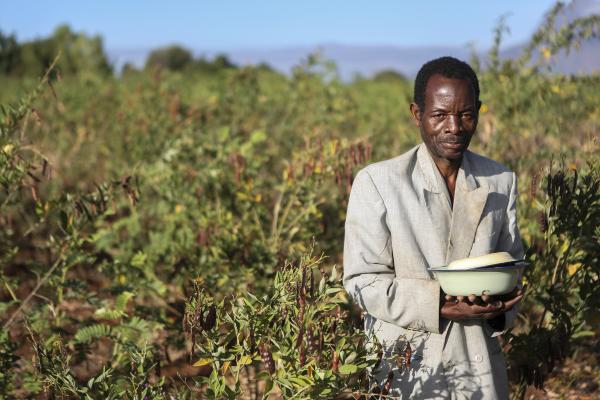MY WIFE AND I left London for Africa in 1952 to serve as “agricultural missionaries” through the Anglican Church Missionary Society. For 65 years we have been living and working with farming families who live off less than five acres of land. In fact, 85 percent of the world’s farms are less than five acres.
The International Fund for Agricultural Development estimates that there are some 500 million small farms worldwide, and more than 2 billion people depending largely on agriculture for their livelihoods. Smallholder farmers produce 80 percent of the food consumed in Asia and sub-Saharan Africa.
Despite this achievement many of these farming families are among the poorest people in the world and have the least access to public services. Frequently described as conservative, backward, and ignorant, they in fact survive and produce under conditions in which the vast majority of the world’s urban people would be completely at a loss. Their dominant features are resilience and a capacity for hard work.
Innovation and adaptation
Across Asia and sub-Saharan Africa, examples abound of smallholder farmers making major changes to their farming practices in response to new technologies that they recognize as meeting their particular needs. In the early 1950s, on the border between what was then the Sudan and Belgian Congo, farmers were living in a traditional, largely cashless economy with a limited range of crops. Distances were great and there was no public transportation. Bicycles were greatly desired. Men sometimes traveled 700 miles south as indentured labor for two years in order to obtain a bicycle. This had a disastrous impact on family life in an inhospitable forest environment.
My wife and I moved into a village in this region and became part of the local community as agricultural missionaries. Our neighbors taught us how to survive and feed ourselves. But after a couple of years, we could see how we might improve on the situation. We brought in a half dozen new food crops from other parts of the world and introduced coffee as a cash crop, which did away with the need for men to leave home.
Because we were farming ourselves, we knew the constraints that our neighbors faced and were able to choose options that fit everyone’s circumstances. Within a few years the community had adopted a range of new foods, and not only did every man own a bicycle without leaving home but the women had a grinding mill to save them the drudgery of grinding tiny millet seeds on a grindstone for hours on end.
We were then moved to Uganda, where we were asked to serve the agricultural needs of the poorest county in the country. It was an area of high, cool, acid moorland, with soils that were quite unsuitable for food crops, apart from tiny patches in valley bottoms. There was no access road. We walked 16 miles in and out to our home. People there were desperately poor, and the children wore goat skins.
Fortunately, there is a crop that thrives on highly acidic soil: tea. We lived in a simple home in the area, learned the local language, and talked to people about the possibility of growing this strange new plant of which most of them had neither seen nor heard.
We helped the first 200 farmers to establish tea gardens. When they knew what to do, we moved on. Today 2,000 families own 6,500 acres of tea in that region. They have borrowed from the bank and built a factory that produces some 50,000 pounds of proc-essed tea per day. Now there are banks, a hospital, and a string of shops in the area.
In the 1980s, I was involved with small-scale irrigation projects in northern Nigeria. For centuries people in this region had used shallow wells and buckets to irrigate small areas of vegetables. We introduced simple methods of making tube wells, derived from India, and brought in small, portable, engine-driven pumps. Twenty thousand pumps were sold for cash in five years. Production increased manyfold. With a large urban population growing rapidly every year, the farmers had no problem selling their vegetables to merchants from the cities. The regional economy of the area and its productivity was profoundly changed.
Of course, smallholder farmers making these innovative changes are not confined to one continent. In India, the Bengal famine of the 1940s killed more than 2 million people. With a rapidly growing population, it was predicted that there would be a comparable famine every five years. In reality, there has not been a single one. Farmers were introduced to high-yielding seeds and enhanced plant nutrition. Although the population of India has grown fourfold, the average daily per capita consumption of calories has increased by more than 400, with food produced by 98 million smallholder farming families.
Now, of course, smallholders also face the destruction caused by climate change. While it has yet to significantly impact the moist intertropical zone in which Malawi lies, the best way to “climate proof” crops is to ensure that they are strong, well-fed, and healthy. The main challenge to policymakers in climate-impacted regions is how to help poor people gain access to the inputs essential to achieve this objective. In drier parts of the continent, reduced rainfall is forcing farmers to adopt lower-yielding but drought-tolerant crops such as bulrush millet, with long-term implications for food availability for a growing population.
Failed projects
Small-scale farmers across the world have made many successful changes over the past 60 years, but I suspect the list of failed projects intended to help them is even longer. I attend meetings with leading academics from agricultural institutions who complain bitterly about “backward” and “ignorant” farmers who are not making use of these academics’ research and proposals.
Why is Africa littered with failed projects and rusting equipment introduced by well-meaning people? All too often it stems from a lack of understanding of the reality of the local situation facing people. For example, a proposal that might increase yields by 50 percent but requires twice as much labor as a family can muster is unlikely to be widely adopted, no matter how technically sound.
While the advertisement “For just $40 you could purchase this insecticide that would greatly increase your yields” may sound reasonable to a well-paid academic, it’s of little interest to people living on less than a dollar a day. Too often smallholder farmers are approached by outsiders with a “I have come to tell you what would be good for you” message, rather than “Would you share with me your fundamental challenges so that we can see if any knowledge I have might be of use to you?”
The great missionary thinker Max Warren, who headed the Church Missionary Society, pressed upon us the need to “sit where they sit.” Far too many people attempt to improve the lot of smallholder farmers without really knowing where people sit, let alone taking the time to join them there. If one does not know the questions that farmers are asking, then one’s “answers” are unlikely to satisfy their needs.
At this level there is undoubtedly a role for members of the faith community to provide the sympathy and an in-depth understanding of a community’s challenges by “sitting where they sit” to fully appreciate the limitations they face. Many missionaries and other people of faith have shown such qualities, but this must also be matched with a deep understanding of agricultural and technical issues. If this is not present, then failure may follow. Success is most likely when people who have an in-depth understanding and sympathy with a community join that with a genuine knowledge of agricultural issues.
Why do farming families remain poor?
Hundreds of millions of the world’s poorest people live in rural areas and make their living by farming. Over the past 50 years, major efforts have been made to lift people out of poverty, so why are there more rural poor today than half a century ago?
One answer is plot size. If one’s total farm size is two acres and from that plot one both has to feed a family and sell a surplus for cash, then in many cases that surplus will be too small to lift a family out of poverty. This is the situation of many millions of small-scale farmers. Some of the fortunate few who live in wealthier countries, such as Japan and the United States, can benefit from generous government subsidies.
Change will come from off the farm—by generating work opportunities that offer better returns than smallholder farming, releasing land for more-sustainable plot sizes, and providing an increased and more-profitable market for the producers.
China has successfully lifted large numbers of people out of extreme poverty. The rest of Asia and sub-Saharan Africa have been less successful. The challenge increases as the demand declines for an unskilled and poorly educated labor force. Why are people poorly educated? In many countries, it’s proving difficult to provide high-quality services to remote and scattered rural communities. Good teachers are reluctant to move to villages with no electricity or running water. The same applies to doctors and nurses.
In my own country of Malawi, it is not just the shortage of staff that affects education and health, but the availability of power. Only 2 percent of rural Malawian families have access to electricity. This denies children the opportunity for reading or studying after 6 p.m. or 7 p.m. all through the year. It also has an obvious impact on the quality of medical services. Hopefully solar power will improve this situation over the next few decades, but so far it has proven difficult to provide at a cost that the poor can afford.
The situation is not helped by the lack of sympathy and understanding that exists among much of the urban population toward the rural poor. This is a challenge to the faith community to take up the case of those who have little voice in policymaking, both in the countries concerned as well as in those wealthy nations that offer development aid. It is not just the volume of aid that matters, but to whom it is directed and how effectively it is managed.
Few Western politicians or policymakers have a detailed knowledge of the needs of the world’s rural poor. In my experience, they are prepared to listen to someone who does possess that knowledge. With modern technology it is not that difficult to become well-informed on a particular issue in a poor country and so be in a position to put pressure on those making decisions about aid allocation.
One of the great benefits of the Peace Corps has been to spread people with experience of poor rural communities as a leaven throughout U.S. society. Christian vocation can surely extend to such groups and people and not just to service within the boundaries of the church.
The many resilient and hard-working rural families who have been left behind in the economic developments of the past half century deserve more concern from those who, by the good fortune of birth, have prospered over the same period.

Got something to say about what you're reading? We value your feedback!
